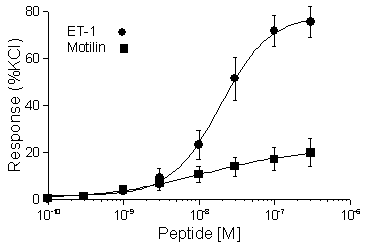| pA2 online © Copyright 2004 The British Pharmacological Society |
116P
University of Bath Summer Meeting July 2004 |
|
Motilin mediates vasoconstriction in human coronary artery in vitro J. J. Maguire, R. E. Kuc & A. P. Davenport. Clinical Pharmacology Unit, University of Cambridge, Level 6 Centre for Clinical Investigation, Box 110 Addenbrooke’s Hospital, Cambridge. CB2 2QQ, UK |
|
Motilin, a 22 amino acid peptide originally isolated from the gastrointestinal tract, has been paired with the orphan G-protein coupled receptor GPR38 (Feighner et al., 1999). We have demonstrated the presence of specific motilin binding sites in the human cardiovascular system, including the vascular smooth muscle layer of arteries and veins (Kuc et al., 2003). Vascular responses to motilin have been observed, with a depressor effect seen in pithed rat, in vivo (Eimerl et al., 1985) and endothelium-dependent relaxation of porcine coronary artery in vitro (Higuchi et al., 1994). Direct effects on vascular smooth muscle have not been reported. Therefore our aim was to determine the action of motilin on endothelium-denuded human coronary artery in vitro.
Human coronary artery (CA) was obtained, with ethical approval, from 12 patients transplanted for cardiomyopathy (n=8, 2 female, 6 male; 33-54 years), ischaemic heart disease (n=1, male; 44 years) or lung disease (n=2, 2 female 24 and 35 years). Rings (4mm) of endothelium-denuded CA were set up in 5ml organ baths, containing Krebs’ solution (37 °C), for isometric tension recordings. Following normalisation to establish optimal basal tension, cumulative concentration-response curves were constructed to endothelin-1 (ET-1) and motilin (1x10-10-3x10-7M). Experiments were terminated by the addition of 100mM KCl to determine the maximum possible response and agonist responses were expressed as a percentage of this maximum. Data were analysed using a four parameter logistic equation (FigP, Biosoft, Cambridge, UK) to determine pD2 and Emax values. Data are the mean±s.e.mean and n-values are the number of patients.
ET-1 contracted all arteries tested with a pD2 value of 7.77±0.13 and Emax of 75.3±6.4% KCl (n=11). Responses to motilin were more varied. Motilin was without effect in arteries from 3 patients and produced responses of <5% KCl in arteries from 3 patients. Vasoconstrictor responses of between Emax 10-53% KCl were obtained in arteries from 6 patients with pD2 value of 7.97±0.23 and mean Figure 1. Concentration response curves to Emax of 19.8±5.9% (n=6) (Fig. 1).

ET-1 and motilin in human coronary artery.
We have demonstrated, that in common with other orphan receptor ligands such as urotensin-II and neuromedin U-25, motilin is a potent, low efficacy vasoconstrictor of human coronary artery and we speculate that vascular motilin receptors, present on the smooth muscle, may be activated either by motilin circulating in the plasma or released locally from nerve terminals.
Eimerl, J. et al., (1985). Neuropeptides, 6, 157-165
Feighner, S.D. et al., (1999). Science, 284, 2184-2188
Higuchi, Y. et al., (1994). Biochem. Biophys. Res. Commun., 202, 346-353
Kuc, R.E. et al., (2003). Br. J. Pharmacol., 138, 165P